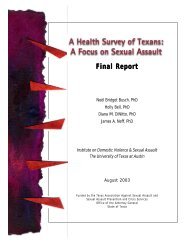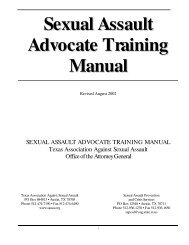Sexual aSSault LEGAL ADVOCACY MANUAL - Texas Association ...
Sexual aSSault LEGAL ADVOCACY MANUAL - Texas Association ...
Sexual aSSault LEGAL ADVOCACY MANUAL - Texas Association ...
You also want an ePaper? Increase the reach of your titles
YUMPU automatically turns print PDFs into web optimized ePapers that Google loves.
How Does a Sex Offender Get Civilly Committed?<br />
Not every repeat sexually violent offender, as defined above, will be subject to civil commitment. In<br />
order to be civilly committed, Tex. Health And Safety Code § 841.081 requires that the repeat<br />
sexually violent offender must also have a “behavioral abnormality” that makes him or her a “sexually<br />
violent predator.”<br />
If a person is a repeat sexually violent offender, a procedure is set in motion before his or her release<br />
to determine whether the person is a sexually violent predator who should be civilly committed upon<br />
release. A prosecutor must petition the court to find that the offender is a sexually violent predator,<br />
and the offender can be civilly committed by a jury trial, a trial before a judge, or an agreed order. The<br />
remainder of this section will examine that procedure.<br />
The Civil Commitment Process<br />
Preliminary Recommendations<br />
Sixteen months prior to an offender’s release from prison or a mental health facility, TDCJ identifies<br />
all sex offenders who have more than one sexually violent offense. Section 841.022, Health and Safety<br />
Code, establishes a multidisciplinary team to evaluate which sex offenders may meet the qualifications<br />
as sexually violent predators. The multidisciplinary team consists of representatives from the Council on<br />
Sex Offender Treatment, TDCJ, TDCJ-Victim Services, the Department of State Health Services Mental<br />
Health Division, and the Department of Public Safety.<br />
In order to determine whether an offender might qualify as a sexually violent predator, it reviews<br />
offenders’ identifying information, criminal history, treatment history, behavioral record from the<br />
institution, victim impact statements, protest letters, and an assessment of the offender’s likelihood to<br />
commit another sexually violent offense upon release. Based on that information, the team assesses<br />
whether the person is a repeat sexually violent offender and determines whether the person is likely to<br />
commit a sexually violent offense after release. If a majority of the members agree, then the offender is<br />
recommended for the first behavioral abnormality assessment.<br />
If, after an assessment, an expert believes the person suffers from a behavioral abnormality, TDCJ or<br />
MHMR will notify the attorney representing the state of the results of the assessment.<br />
The Petition Alleging Predator Status and Trial<br />
If the attorney representing the state receives a notification from TDCJ or MHMR as described above,<br />
she or he may choose to file a petition to have the offender classified as a sexually violent predator.<br />
<strong>ADVOCACY</strong> ACTION: Importantly, during the discovery stage of any civil commitment<br />
court proceeding described in this section, an offender has no right to personal<br />
information identifying a victim. Under Tex. Health And Safety Code § 841.1462, that<br />
information is privileged. (p. 59, Privacy)<br />
Experts from both sides will re-evaluate the offender for a behavioral abnormality prior to the trial. Most,<br />
if not all, the evidence presented during this trial will usually be from mental health experts who can<br />
testify about the offender’s behavioral abnormality assessment.<br />
At the trial, the judge or jury will determine whether the offender is a sexually violent predator. The state<br />
must prove that beyond a reasonable doubt, and if there is a jury, the verdict must be unanimous.<br />
78
















